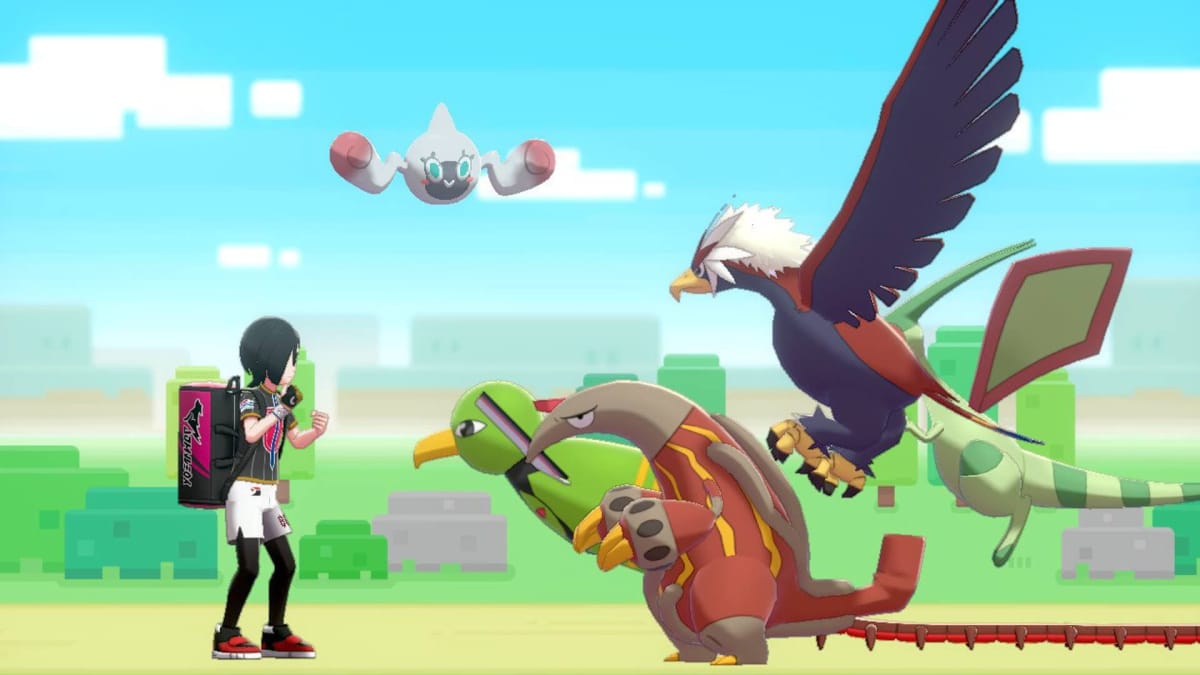If you've decided to get involved in the competitive Pokemon scene, then you'll need to learn all about IVs, EVs, and maybe even Eevees too. It can be a daunting task "going pro" at any game, but even more so with an RPG. That's why we've put together this Pokemon Sword and Shield EV Training Guide to help you wrap your head around the mountain of new stuff you'll have to get used to.
If you enjoy this one, we also have a guide about getting perfect IVs in Pokemon Sword and Shield. Failing that, we also have a review of the latest mainline game in the franchise: Pokemon Scarlet and Violet.
Pokemon Sword and Shield EV Training Guide
For anyone just getting into competitive battling, Effort Values, or EVs, are bonuses applied to your Pokemon’s primary stats. Like IVs, these can help maximize your stats to be the highest they can be, so the highest possible number for HP, Attack, Speed, or what have you. Unlike IVs, EVs are wholly controlled by the player, mainly because of the methods available to ‘train’ your Pokemon to maximize its potential.
That is pretty much the theme here; EVs represent the time training Pokemon to their full potential, and in Sword and Shield, training Pokemon with EVs has become extremely easy compared to previous generations. So, this guide will go through some basic information you need to know about EVs, and how to train them up efficiently to build up a competitive Pokemon.
Sword and Shield EV Training - Math

The first thing you need to understand about EVs is the basic math behind them. Any time a Pokemon fights in a wild or trainer battle, they get effort points, which are further divided by the six in-game stats of HP, Attack, Defense, Special Attack, Special Defense, and Speed. So, if you fight a Rookidee on route 1, fainting it yields one Speed effort point. Every four points turns into a full EV, which in turn leads to a +1 in that specific stat, so you would need to knock out four Rookidees to get one Speed EV to gain an extra point in Speed.
A Pokemon has a cap on how many EVs they can gain, which is at 510 EV points. These 510 points are also capped based on your stats; one stat can have a maximum of 252 EV points. For most, the best strategy is one of min-maxing, beefing up your two most useful stats to 252 for the full stat bonus. The reason for that 252 is because you need four effort points per EV gain. This totals an extra 63 points in each stat. When combined with perfects IVs and a beneficial nature that add a 10% boost to that base stat, it can lead to Pokemon with powerful potential in battle.
So, for example, let’s say we want to EV train a Dreadnaw for competitive purposes. Dreadnaw has a high Attack stat and we want it to be as fast a possible, so we would want to train up its Attack and Speed stats to a full 252 EV points. Since we know Rookidee gives us 1 Speed point per knockout and is relatively low level, we can in theory fight and faint more than 1,000 Rookidees on route 1 to get the full 252 EV yield.
In practice, of course, fighting 1,000 of the same Pokemon is ridiculous, which is why over the years Game Freak has added a ton of methods, mechanics, and even bonuses to make gaining EVs extremely easy.
Sword and Shield EV Training - Old-school

The first, and old-school method, is a form of the previous one above: wild Pokemon EV training. While it is arguably the most tedious and even possibly obsolete thanks to new mechanics, EV training is still the standard ‘go-to’ method that persists, even with new mechanics on top.
To start EV training, players need to access the post-game and win some Battle Points, or BP, from the Battle Tower. Players then need to go to the BP seller in the central Pokemon Center in Hammerlocke and purchase the Power items. The Power Items, introduced several generations ago, are held items that enhance the amount of effort points gained when fainting Pokemon.
The power items give players a +8 to the effort points whenever you fight a Pokemon with that stat. Their cost is small at 10 BP a piece, and obtaining BP is easier than previous generations. The power items are a must for multiple forms of EV training but are necessary for fighting wild Pokemon.
One optional but immensely helpful mechanic is the hidden Pokerus mechanic. Pokerus was originally introduced back in Generation 3, and is a rare, beneficial disease that doubles your EV gain when training. The virus stops spreading after a few days, but the benefits of Pokerus remain, making the gaining of EV points relatively swift when compared to the older method.

Let's revisit our Dreadnaw scenario from before. To maximize our EV yields from the Rookidee, we would need it to hold the Speed EV power item, the Power Anklet, and find a way to contract Pokerus. These two combined turns that 1-point yield into an 18-point yield that is equal to 4 and a half EVs; 1 for the Rookidee, +8 for the power item, and that 9 is then doubled by Pokerus. It should be noted that some Pokemon also provide two effort points when you faint them in the wild instead of one, which can turn your point yields to an even 20, or 5 EVs at a time.
Now, previous generations also doubled effort points in other ways, such as horde and SOS battles, which can yield close to 40 EVs in one fight if you know what you are doing. While Pokemon Sword and Shield doesn’t have an analogous mechanic for EV training, the 18-point yield cuts down drastically the number of Pokemon you need to fight, from over 1,000 to about 100 instead.
Below is a list of easy Pokemon to find and faint for EVs, based on the stat they provide. I tried to list two Pokemon per stat; one for 1 EV yield, one for 2 EV yield, and their locations.
- HP: Skwovet (1 EV, Route 1) | Wobbuffet (2 EV, Route 5)
- Attack: Chewtle (1 EV, Route 2, Lakeside) | Bewear, Crawdaunt and Machoke (2 EV, Axew's Eye, Wild Area)
- Defense: Wooloo (1 EV, Route 1)
- Special Attack: Gastly (1 EV, Watchtower Ruins, Wild Area)
- Special Defense: Nikit (1 EV, Route 1)
- Speed: Rookidee (1 EV, Route 1) | Ninjask (2 EV, Stony Fields, normal and rain weather, Wild Area)
Most of the Pokemon found on Route 1 are well worth EV training, if you have the time for it.
Sword and Shield EV Training - Vitamins and Other Items

The reason why the classic EV training method may be obsolete now is due to mechanics changes in Sword and Shield governing vitamins. Vitamins are expensive, rare items that raise the EV points of a single Pokemon by 10, and in previous generations had a capped use of 10 total; meaning Pokemon can only get their EVs raised to 100 from using 10 vitamins.
In Sword and Shield, that cap has been removed, and players can now feed their Pokemon 25 vitamins at a time to maximize their EVs instantly. The cost of this is still expensive; a total of 250,000 poke dollars for one set of 25 vitamins. However, there are multiple ways to mitigate this cost through cash grinding.
Grinding for cash in Pokemon Sword and Shield is easy, and once again heavily involves the Wild Area. Players can, of course, grind for money by re-entering the end-game tournaments against the gym leaders with an amulet coin, or grind for money by using the move Pay Day. There are two new methods thanks to the Wild Area that make this faster, both of which involve grinding for Watts.
Going to any inactive raid den yields 200 Watts, while active ones gain you 2,000 and a Max Raid battle. The dens reset each day or when all active dens have been completed, so players can farm Watts across the Wild Area for high returns over a short amount of time. They can also gain small amounts of Watts doing Roto Rally races or fighting brilliant aura Pokemon.
The reason to do this is that accumulating tons of Watts can be used to buy rare items. Most of the focus will be on wishing pieces and TRs, but for making money, players can utilize the services of the digging brothers, located near the Wild Area daycare, or purchase Luxury Balls.

The digging brothers can, for 500 Watts, dig for treasures. Many of these treasures, like rare bones, star pieces, or comet shards, have high resale values that accumulate easily. Others can be repeated valuable items, like bottle caps and fossils, that if not needed by the player can be sold for decent money as well. Luxury balls, on the other hand, are a decently expensive item in most shops, but for 100 Watts at a time, they can be purchased in bulk and sold back to shops for a nice return.
This is all important if players want to grind money for vitamins, making the entire process for EV training a time sink of earning cash over earning effort points. It should be noted two other items can be used for EV training as well: Wings and Berries. Wings specifically raise an EV by a single point, which can be helpful in fine tuning EV gains with oddball numbers. Finally, certain berries lower your EV points by 10, so in case players make a mistake, or want to re-train a Pokemon, the option is also available to you.
The following berries affect EV training by lowering your points by 10.
- Pomeg Berry: Lowers HP
- Kelpsy Berry: Lowers Attack
- Qualot Berry: Lowers Defense
- Hondew Berry: Lowers Special Attack
- Grepa Berry: Lowers Special Defense
- Tamato Berry: Lowers Speed
Sword and Shield EV Training - The Pokejob Method

The final method is using Pokejobs, which is a passive but effective method to also bulk EV train Pokemon. Pokejobs is a new mechanic that sends your Pokemon out to do odd jobs for different businesses in Galar. It not only can give the player some minor rewards, such as extra money or items, but it also gives your Pokemon a massive XP boost depending on how long they are on the job.
For EV training, a set of jobs from Hammerlocke University become available to you halfway through the game. These six jobs allow the player to send up to 10 Pokemon to essentially be EV trained in a single stat. Every hour you send your Pokemon to be EV trained, they gain 4 EVs in that stat. Players can send their Pokemon for a short time or a full 24-hour period to be EV trained, and the breakdown of what you earn in stats is as follows:
- A Little While: 1 hour (4 EVs)
- Very Short: 2 hours (8 EVs)
- Short: 3 hours (12 EVs)
- Long: 4 hours (16 EVs)
- Very Long: 8 hours (32 EVs)
- Half Day: 12 hours (48 EVs)
- Whole Day: 24 hours (96 EVs)
In addition to this, having the power items attached to your Pokemon also add their bonus to EV gaining. One power item, the Macho Brace, is incredibly useful here, as it acts like held-item version of Pokerus where it doubles your EV point yield. This means you can give up to 10 Pokemon 10 Macho Braces at a time and double their EV points while on the Pokejob, meaning that a single Pokemon can earn a total of 192 EVs in 24 hours, a massive point yield that can help players bulk EV train Pokemon quickly.
Sword and Shield EV Training - Final Thoughts

In truth, using vitamins and Pokejobs is more efficient than the standard EV training, but all three methods can make maximizing EVs, even for newcomers to competitive play, simple and effective. The results are often worth the effort too; fully EV trained Pokemon can mean the difference between victory or defeat in a competitive battle. Sometimes, the breakdown of your EV trained stats can also help determine the build and function of your Pokemon as well; making EV training a fully modular and customizable experience that puts other RPG character builds to shame at times.
With IV and EV training out of the way though, the next steps involve focusing on what strategies to employ when playing competitively. There is certainly no shortage of viable move sets, roles, and even combinations that Pokemon can take advantage of, so our next guide will go into a standard breakdown of important things to know about basic competitive strategies. Be sure to check out that article as we continue to go through these sessions of the battle academy. Until then, class is dismissed.
Have a tip, or want to point out something we missed? Leave a Comment or e-mail us at tips@techraptor.net













